Workplace Learning Report: Exploring Workplace Modules and Strategies
VerifiedAdded on 2022/11/02
|11
|2706
|244
Report
AI Summary
This report examines workplace learning by analyzing three key modules: Business Meetings, Team Leadership, and Performance Metrics. The student, drawing from their volunteer experience in a community-based organization, evaluates the effectiveness of these modules, highlighting issues such as the exclusion of volunteers from meetings, lack of clear leadership, and absence of performance feedback. The report discusses the importance of effective business meetings for communication and feedback, the stages of team development, and the need for performance metrics that include feedback and SMART goals. Recommendations include inclusive meeting practices, improved team leadership through better communication and task assignment, and the implementation of performance feedback mechanisms. The report concludes with reflections on career and employability enhancement, emphasizing the importance of inclusive workplaces, guidance, and communication skills.
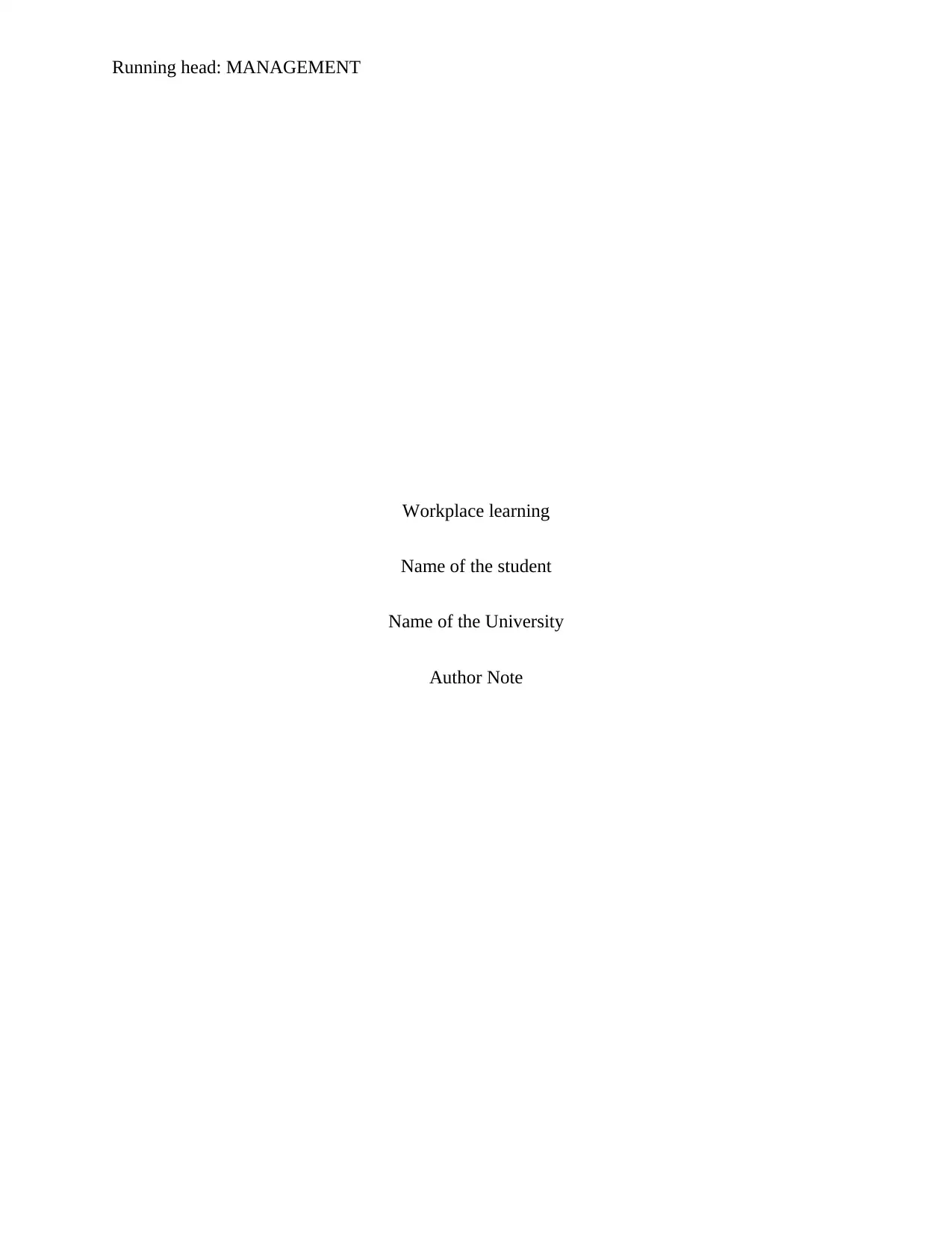
Running head: MANAGEMENT
Workplace learning
Name of the student
Name of the University
Author Note
Workplace learning
Name of the student
Name of the University
Author Note
Paraphrase This Document
Need a fresh take? Get an instant paraphrase of this document with our AI Paraphraser
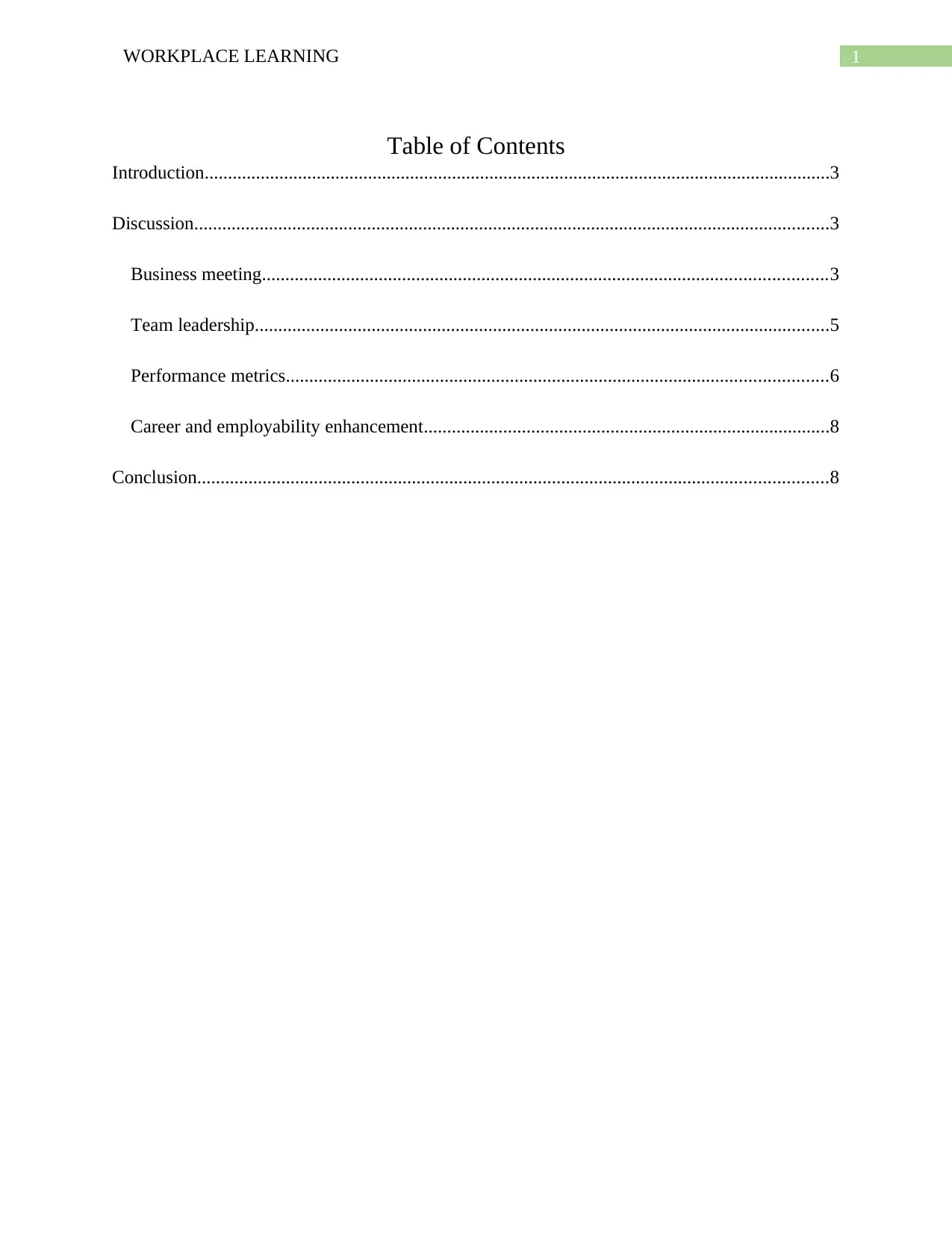
1WORKPLACE LEARNING
Table of Contents
Introduction......................................................................................................................................3
Discussion........................................................................................................................................3
Business meeting.........................................................................................................................3
Team leadership...........................................................................................................................5
Performance metrics....................................................................................................................6
Career and employability enhancement.......................................................................................8
Conclusion.......................................................................................................................................8
Table of Contents
Introduction......................................................................................................................................3
Discussion........................................................................................................................................3
Business meeting.........................................................................................................................3
Team leadership...........................................................................................................................5
Performance metrics....................................................................................................................6
Career and employability enhancement.......................................................................................8
Conclusion.......................................................................................................................................8
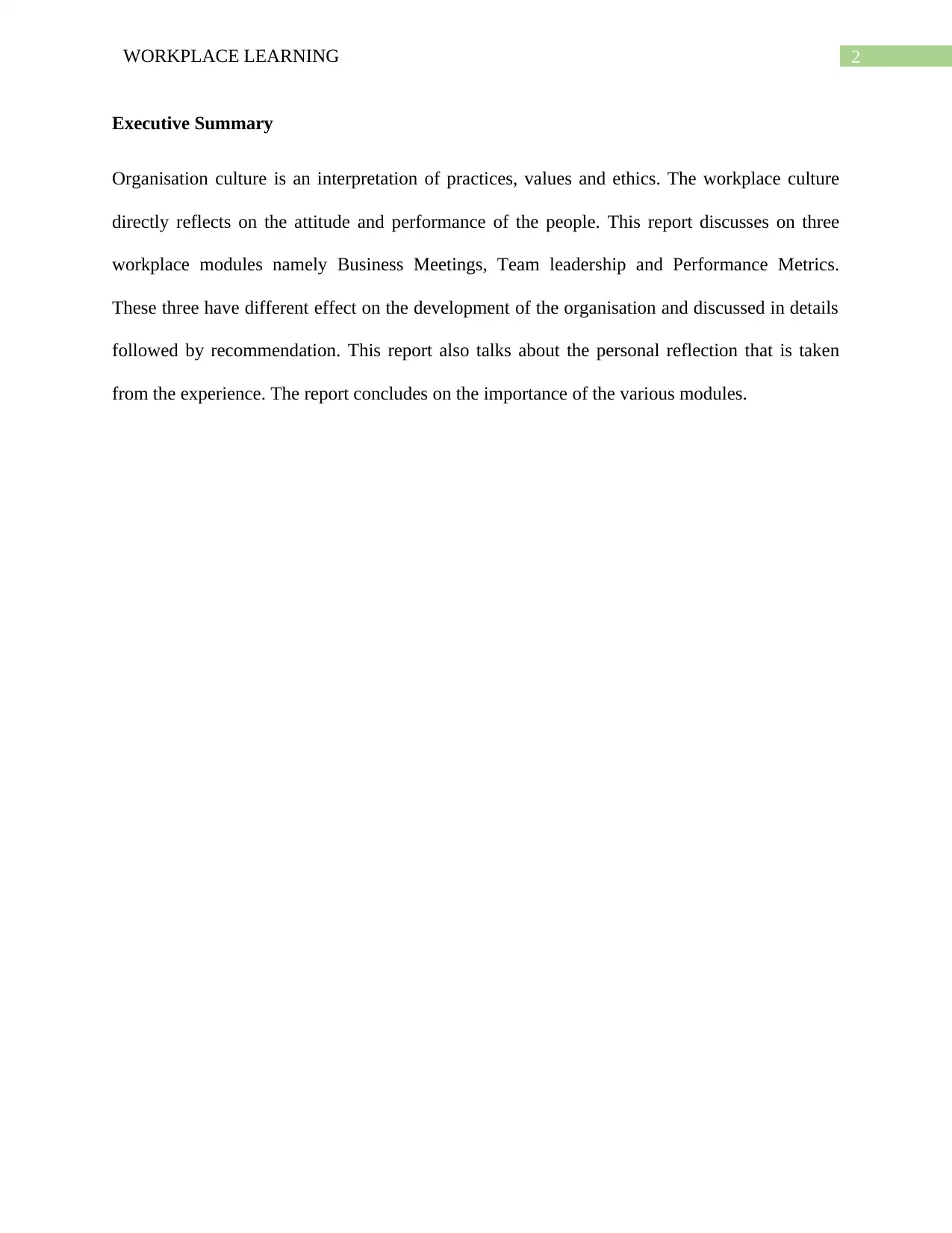
2WORKPLACE LEARNING
Executive Summary
Organisation culture is an interpretation of practices, values and ethics. The workplace culture
directly reflects on the attitude and performance of the people. This report discusses on three
workplace modules namely Business Meetings, Team leadership and Performance Metrics.
These three have different effect on the development of the organisation and discussed in details
followed by recommendation. This report also talks about the personal reflection that is taken
from the experience. The report concludes on the importance of the various modules.
Executive Summary
Organisation culture is an interpretation of practices, values and ethics. The workplace culture
directly reflects on the attitude and performance of the people. This report discusses on three
workplace modules namely Business Meetings, Team leadership and Performance Metrics.
These three have different effect on the development of the organisation and discussed in details
followed by recommendation. This report also talks about the personal reflection that is taken
from the experience. The report concludes on the importance of the various modules.
⊘ This is a preview!⊘
Do you want full access?
Subscribe today to unlock all pages.

Trusted by 1+ million students worldwide
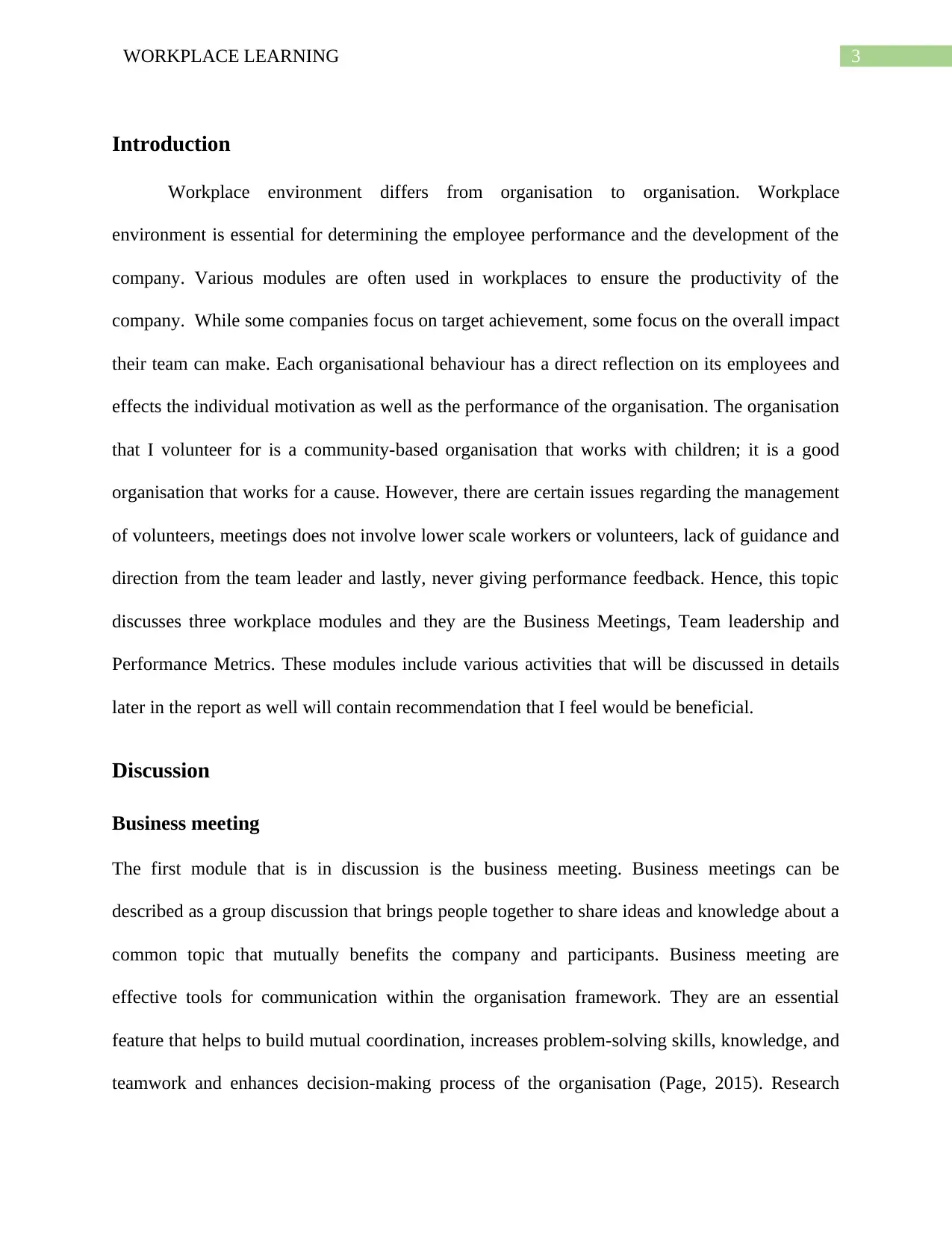
3WORKPLACE LEARNING
Introduction
Workplace environment differs from organisation to organisation. Workplace
environment is essential for determining the employee performance and the development of the
company. Various modules are often used in workplaces to ensure the productivity of the
company. While some companies focus on target achievement, some focus on the overall impact
their team can make. Each organisational behaviour has a direct reflection on its employees and
effects the individual motivation as well as the performance of the organisation. The organisation
that I volunteer for is a community-based organisation that works with children; it is a good
organisation that works for a cause. However, there are certain issues regarding the management
of volunteers, meetings does not involve lower scale workers or volunteers, lack of guidance and
direction from the team leader and lastly, never giving performance feedback. Hence, this topic
discusses three workplace modules and they are the Business Meetings, Team leadership and
Performance Metrics. These modules include various activities that will be discussed in details
later in the report as well will contain recommendation that I feel would be beneficial.
Discussion
Business meeting
The first module that is in discussion is the business meeting. Business meetings can be
described as a group discussion that brings people together to share ideas and knowledge about a
common topic that mutually benefits the company and participants. Business meeting are
effective tools for communication within the organisation framework. They are an essential
feature that helps to build mutual coordination, increases problem-solving skills, knowledge, and
teamwork and enhances decision-making process of the organisation (Page, 2015). Research
Introduction
Workplace environment differs from organisation to organisation. Workplace
environment is essential for determining the employee performance and the development of the
company. Various modules are often used in workplaces to ensure the productivity of the
company. While some companies focus on target achievement, some focus on the overall impact
their team can make. Each organisational behaviour has a direct reflection on its employees and
effects the individual motivation as well as the performance of the organisation. The organisation
that I volunteer for is a community-based organisation that works with children; it is a good
organisation that works for a cause. However, there are certain issues regarding the management
of volunteers, meetings does not involve lower scale workers or volunteers, lack of guidance and
direction from the team leader and lastly, never giving performance feedback. Hence, this topic
discusses three workplace modules and they are the Business Meetings, Team leadership and
Performance Metrics. These modules include various activities that will be discussed in details
later in the report as well will contain recommendation that I feel would be beneficial.
Discussion
Business meeting
The first module that is in discussion is the business meeting. Business meetings can be
described as a group discussion that brings people together to share ideas and knowledge about a
common topic that mutually benefits the company and participants. Business meeting are
effective tools for communication within the organisation framework. They are an essential
feature that helps to build mutual coordination, increases problem-solving skills, knowledge, and
teamwork and enhances decision-making process of the organisation (Page, 2015). Research
Paraphrase This Document
Need a fresh take? Get an instant paraphrase of this document with our AI Paraphraser
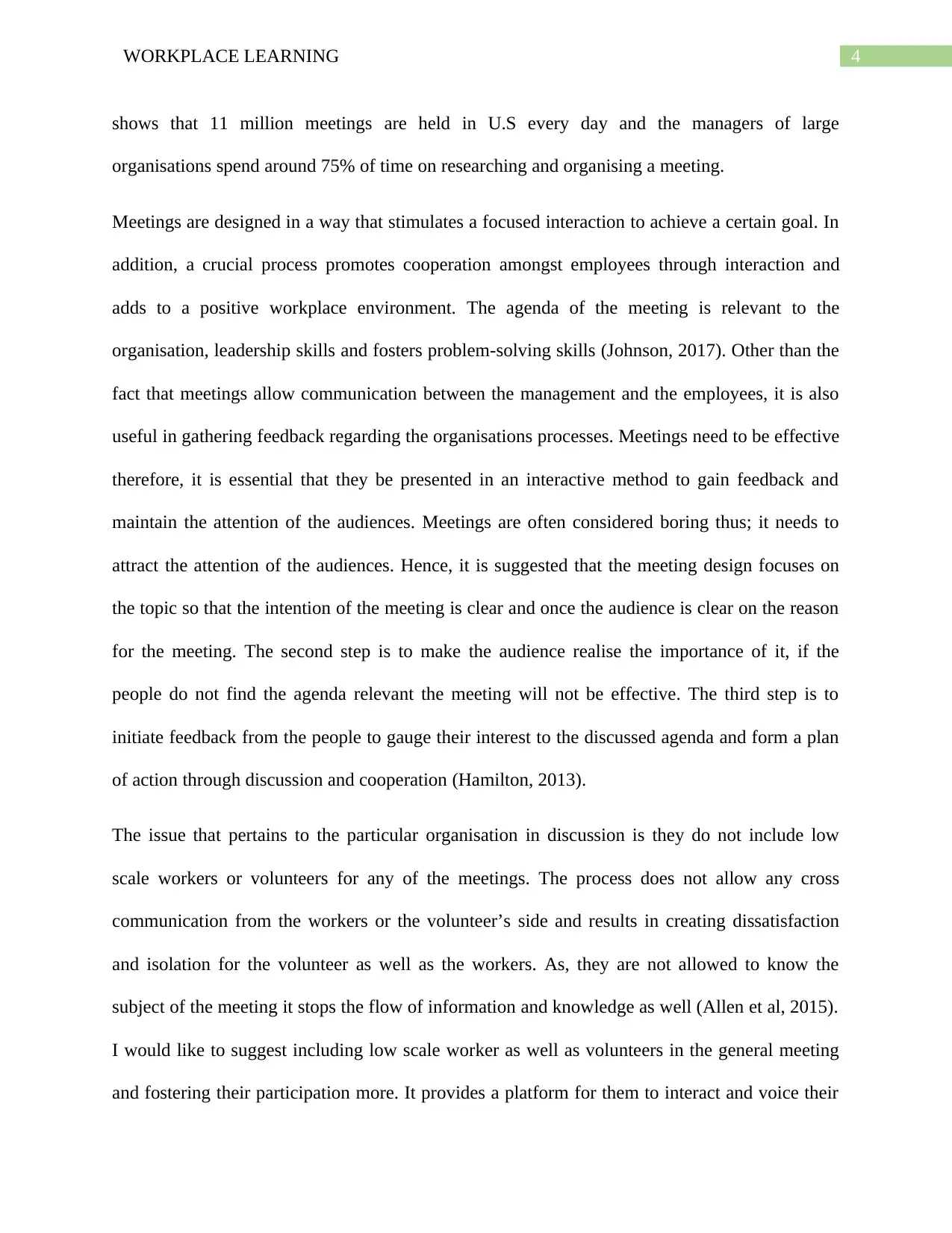
4WORKPLACE LEARNING
shows that 11 million meetings are held in U.S every day and the managers of large
organisations spend around 75% of time on researching and organising a meeting.
Meetings are designed in a way that stimulates a focused interaction to achieve a certain goal. In
addition, a crucial process promotes cooperation amongst employees through interaction and
adds to a positive workplace environment. The agenda of the meeting is relevant to the
organisation, leadership skills and fosters problem-solving skills (Johnson, 2017). Other than the
fact that meetings allow communication between the management and the employees, it is also
useful in gathering feedback regarding the organisations processes. Meetings need to be effective
therefore, it is essential that they be presented in an interactive method to gain feedback and
maintain the attention of the audiences. Meetings are often considered boring thus; it needs to
attract the attention of the audiences. Hence, it is suggested that the meeting design focuses on
the topic so that the intention of the meeting is clear and once the audience is clear on the reason
for the meeting. The second step is to make the audience realise the importance of it, if the
people do not find the agenda relevant the meeting will not be effective. The third step is to
initiate feedback from the people to gauge their interest to the discussed agenda and form a plan
of action through discussion and cooperation (Hamilton, 2013).
The issue that pertains to the particular organisation in discussion is they do not include low
scale workers or volunteers for any of the meetings. The process does not allow any cross
communication from the workers or the volunteer’s side and results in creating dissatisfaction
and isolation for the volunteer as well as the workers. As, they are not allowed to know the
subject of the meeting it stops the flow of information and knowledge as well (Allen et al, 2015).
I would like to suggest including low scale worker as well as volunteers in the general meeting
and fostering their participation more. It provides a platform for them to interact and voice their
shows that 11 million meetings are held in U.S every day and the managers of large
organisations spend around 75% of time on researching and organising a meeting.
Meetings are designed in a way that stimulates a focused interaction to achieve a certain goal. In
addition, a crucial process promotes cooperation amongst employees through interaction and
adds to a positive workplace environment. The agenda of the meeting is relevant to the
organisation, leadership skills and fosters problem-solving skills (Johnson, 2017). Other than the
fact that meetings allow communication between the management and the employees, it is also
useful in gathering feedback regarding the organisations processes. Meetings need to be effective
therefore, it is essential that they be presented in an interactive method to gain feedback and
maintain the attention of the audiences. Meetings are often considered boring thus; it needs to
attract the attention of the audiences. Hence, it is suggested that the meeting design focuses on
the topic so that the intention of the meeting is clear and once the audience is clear on the reason
for the meeting. The second step is to make the audience realise the importance of it, if the
people do not find the agenda relevant the meeting will not be effective. The third step is to
initiate feedback from the people to gauge their interest to the discussed agenda and form a plan
of action through discussion and cooperation (Hamilton, 2013).
The issue that pertains to the particular organisation in discussion is they do not include low
scale workers or volunteers for any of the meetings. The process does not allow any cross
communication from the workers or the volunteer’s side and results in creating dissatisfaction
and isolation for the volunteer as well as the workers. As, they are not allowed to know the
subject of the meeting it stops the flow of information and knowledge as well (Allen et al, 2015).
I would like to suggest including low scale worker as well as volunteers in the general meeting
and fostering their participation more. It provides a platform for them to interact and voice their
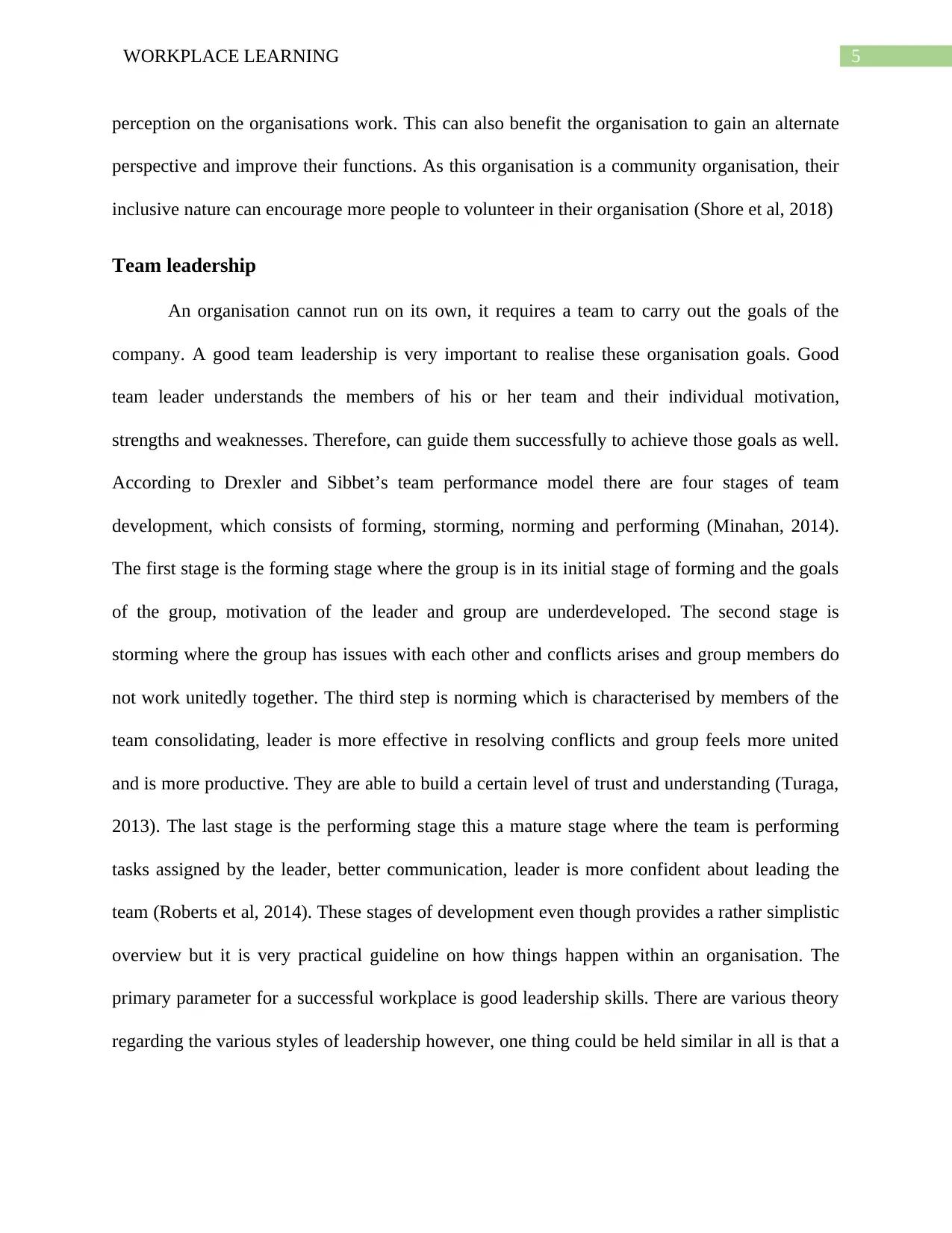
5WORKPLACE LEARNING
perception on the organisations work. This can also benefit the organisation to gain an alternate
perspective and improve their functions. As this organisation is a community organisation, their
inclusive nature can encourage more people to volunteer in their organisation (Shore et al, 2018)
Team leadership
An organisation cannot run on its own, it requires a team to carry out the goals of the
company. A good team leadership is very important to realise these organisation goals. Good
team leader understands the members of his or her team and their individual motivation,
strengths and weaknesses. Therefore, can guide them successfully to achieve those goals as well.
According to Drexler and Sibbet’s team performance model there are four stages of team
development, which consists of forming, storming, norming and performing (Minahan, 2014).
The first stage is the forming stage where the group is in its initial stage of forming and the goals
of the group, motivation of the leader and group are underdeveloped. The second stage is
storming where the group has issues with each other and conflicts arises and group members do
not work unitedly together. The third step is norming which is characterised by members of the
team consolidating, leader is more effective in resolving conflicts and group feels more united
and is more productive. They are able to build a certain level of trust and understanding (Turaga,
2013). The last stage is the performing stage this a mature stage where the team is performing
tasks assigned by the leader, better communication, leader is more confident about leading the
team (Roberts et al, 2014). These stages of development even though provides a rather simplistic
overview but it is very practical guideline on how things happen within an organisation. The
primary parameter for a successful workplace is good leadership skills. There are various theory
regarding the various styles of leadership however, one thing could be held similar in all is that a
perception on the organisations work. This can also benefit the organisation to gain an alternate
perspective and improve their functions. As this organisation is a community organisation, their
inclusive nature can encourage more people to volunteer in their organisation (Shore et al, 2018)
Team leadership
An organisation cannot run on its own, it requires a team to carry out the goals of the
company. A good team leadership is very important to realise these organisation goals. Good
team leader understands the members of his or her team and their individual motivation,
strengths and weaknesses. Therefore, can guide them successfully to achieve those goals as well.
According to Drexler and Sibbet’s team performance model there are four stages of team
development, which consists of forming, storming, norming and performing (Minahan, 2014).
The first stage is the forming stage where the group is in its initial stage of forming and the goals
of the group, motivation of the leader and group are underdeveloped. The second stage is
storming where the group has issues with each other and conflicts arises and group members do
not work unitedly together. The third step is norming which is characterised by members of the
team consolidating, leader is more effective in resolving conflicts and group feels more united
and is more productive. They are able to build a certain level of trust and understanding (Turaga,
2013). The last stage is the performing stage this a mature stage where the team is performing
tasks assigned by the leader, better communication, leader is more confident about leading the
team (Roberts et al, 2014). These stages of development even though provides a rather simplistic
overview but it is very practical guideline on how things happen within an organisation. The
primary parameter for a successful workplace is good leadership skills. There are various theory
regarding the various styles of leadership however, one thing could be held similar in all is that a
⊘ This is a preview!⊘
Do you want full access?
Subscribe today to unlock all pages.

Trusted by 1+ million students worldwide
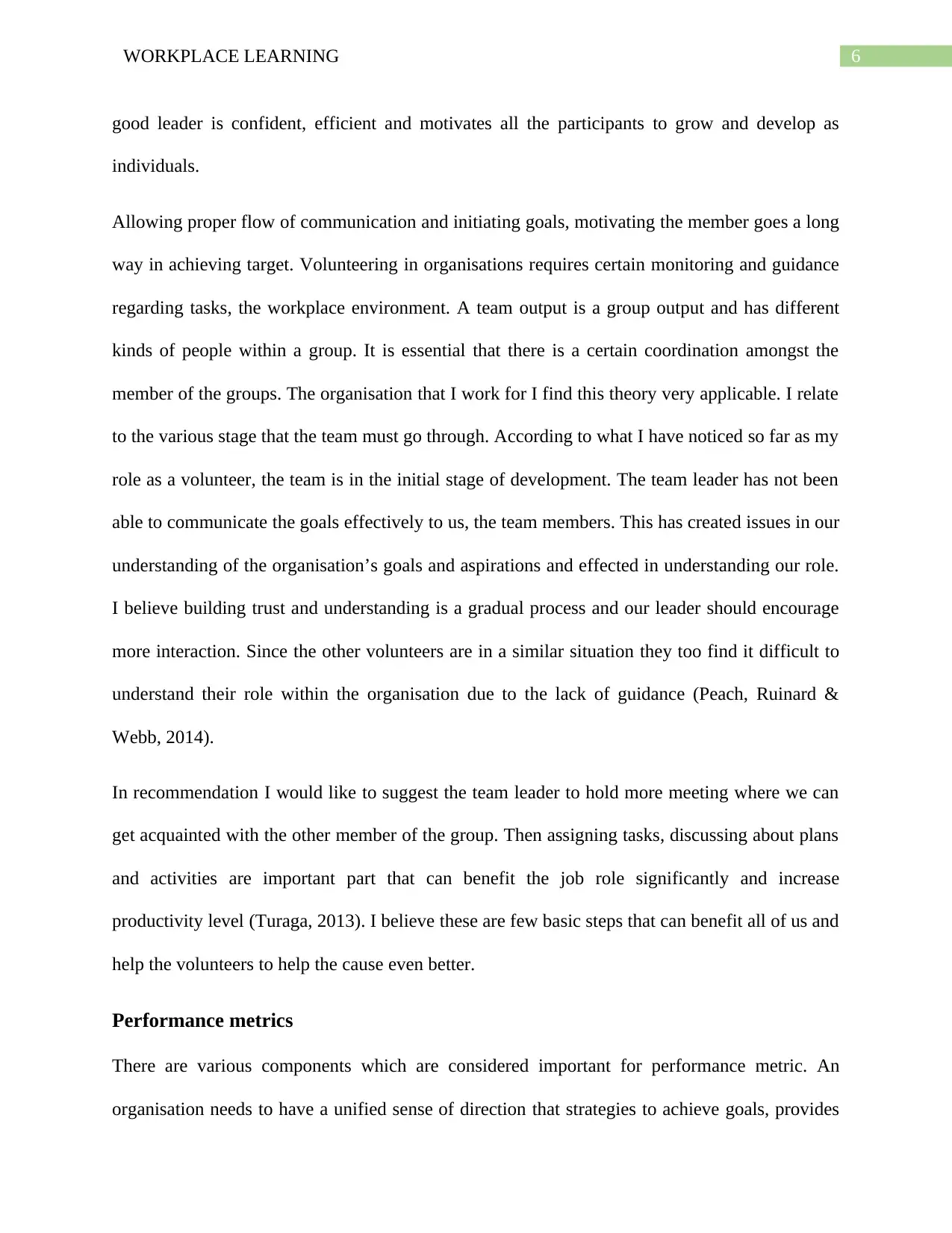
6WORKPLACE LEARNING
good leader is confident, efficient and motivates all the participants to grow and develop as
individuals.
Allowing proper flow of communication and initiating goals, motivating the member goes a long
way in achieving target. Volunteering in organisations requires certain monitoring and guidance
regarding tasks, the workplace environment. A team output is a group output and has different
kinds of people within a group. It is essential that there is a certain coordination amongst the
member of the groups. The organisation that I work for I find this theory very applicable. I relate
to the various stage that the team must go through. According to what I have noticed so far as my
role as a volunteer, the team is in the initial stage of development. The team leader has not been
able to communicate the goals effectively to us, the team members. This has created issues in our
understanding of the organisation’s goals and aspirations and effected in understanding our role.
I believe building trust and understanding is a gradual process and our leader should encourage
more interaction. Since the other volunteers are in a similar situation they too find it difficult to
understand their role within the organisation due to the lack of guidance (Peach, Ruinard &
Webb, 2014).
In recommendation I would like to suggest the team leader to hold more meeting where we can
get acquainted with the other member of the group. Then assigning tasks, discussing about plans
and activities are important part that can benefit the job role significantly and increase
productivity level (Turaga, 2013). I believe these are few basic steps that can benefit all of us and
help the volunteers to help the cause even better.
Performance metrics
There are various components which are considered important for performance metric. An
organisation needs to have a unified sense of direction that strategies to achieve goals, provides
good leader is confident, efficient and motivates all the participants to grow and develop as
individuals.
Allowing proper flow of communication and initiating goals, motivating the member goes a long
way in achieving target. Volunteering in organisations requires certain monitoring and guidance
regarding tasks, the workplace environment. A team output is a group output and has different
kinds of people within a group. It is essential that there is a certain coordination amongst the
member of the groups. The organisation that I work for I find this theory very applicable. I relate
to the various stage that the team must go through. According to what I have noticed so far as my
role as a volunteer, the team is in the initial stage of development. The team leader has not been
able to communicate the goals effectively to us, the team members. This has created issues in our
understanding of the organisation’s goals and aspirations and effected in understanding our role.
I believe building trust and understanding is a gradual process and our leader should encourage
more interaction. Since the other volunteers are in a similar situation they too find it difficult to
understand their role within the organisation due to the lack of guidance (Peach, Ruinard &
Webb, 2014).
In recommendation I would like to suggest the team leader to hold more meeting where we can
get acquainted with the other member of the group. Then assigning tasks, discussing about plans
and activities are important part that can benefit the job role significantly and increase
productivity level (Turaga, 2013). I believe these are few basic steps that can benefit all of us and
help the volunteers to help the cause even better.
Performance metrics
There are various components which are considered important for performance metric. An
organisation needs to have a unified sense of direction that strategies to achieve goals, provides
Paraphrase This Document
Need a fresh take? Get an instant paraphrase of this document with our AI Paraphraser
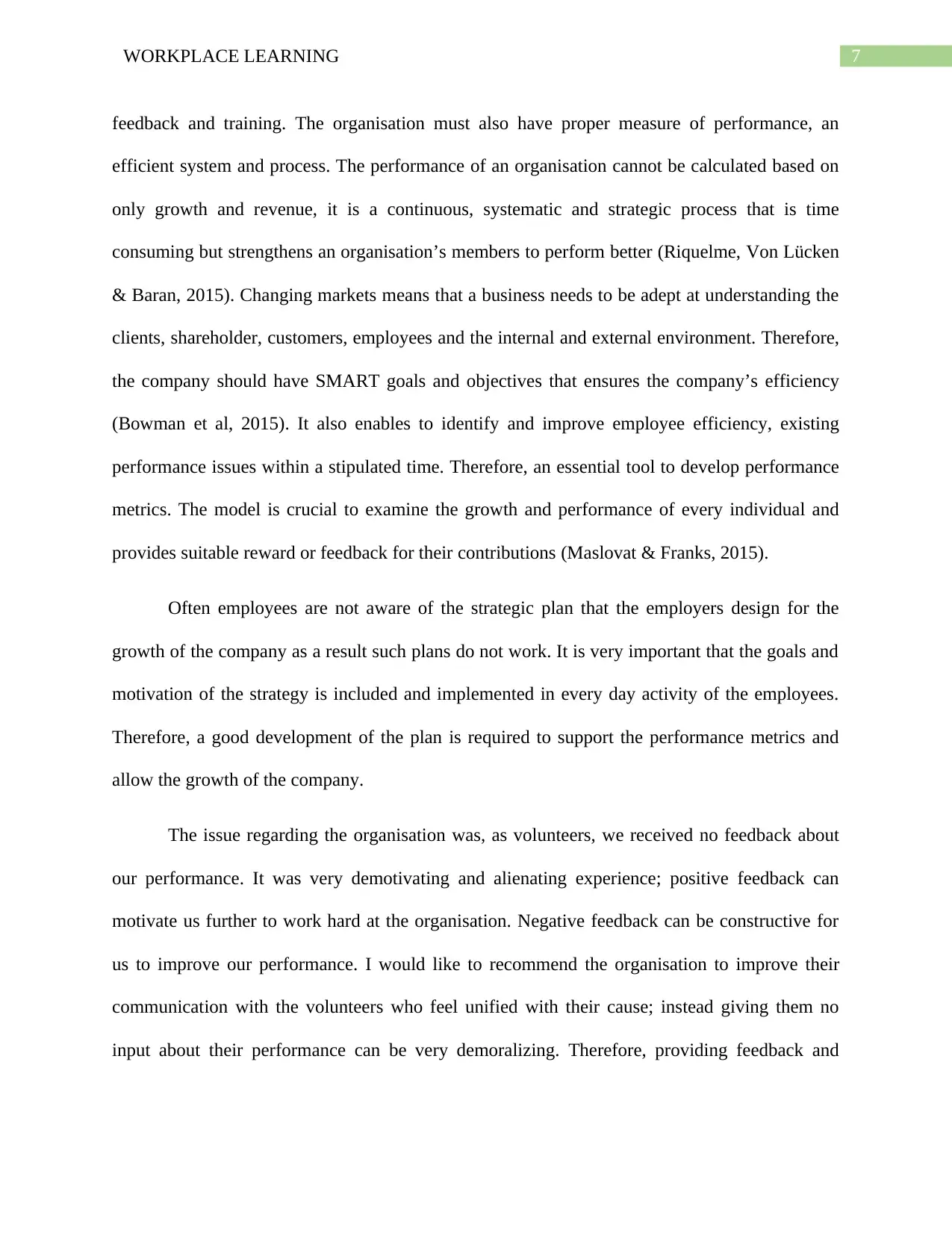
7WORKPLACE LEARNING
feedback and training. The organisation must also have proper measure of performance, an
efficient system and process. The performance of an organisation cannot be calculated based on
only growth and revenue, it is a continuous, systematic and strategic process that is time
consuming but strengthens an organisation’s members to perform better (Riquelme, Von Lücken
& Baran, 2015). Changing markets means that a business needs to be adept at understanding the
clients, shareholder, customers, employees and the internal and external environment. Therefore,
the company should have SMART goals and objectives that ensures the company’s efficiency
(Bowman et al, 2015). It also enables to identify and improve employee efficiency, existing
performance issues within a stipulated time. Therefore, an essential tool to develop performance
metrics. The model is crucial to examine the growth and performance of every individual and
provides suitable reward or feedback for their contributions (Maslovat & Franks, 2015).
Often employees are not aware of the strategic plan that the employers design for the
growth of the company as a result such plans do not work. It is very important that the goals and
motivation of the strategy is included and implemented in every day activity of the employees.
Therefore, a good development of the plan is required to support the performance metrics and
allow the growth of the company.
The issue regarding the organisation was, as volunteers, we received no feedback about
our performance. It was very demotivating and alienating experience; positive feedback can
motivate us further to work hard at the organisation. Negative feedback can be constructive for
us to improve our performance. I would like to recommend the organisation to improve their
communication with the volunteers who feel unified with their cause; instead giving them no
input about their performance can be very demoralizing. Therefore, providing feedback and
feedback and training. The organisation must also have proper measure of performance, an
efficient system and process. The performance of an organisation cannot be calculated based on
only growth and revenue, it is a continuous, systematic and strategic process that is time
consuming but strengthens an organisation’s members to perform better (Riquelme, Von Lücken
& Baran, 2015). Changing markets means that a business needs to be adept at understanding the
clients, shareholder, customers, employees and the internal and external environment. Therefore,
the company should have SMART goals and objectives that ensures the company’s efficiency
(Bowman et al, 2015). It also enables to identify and improve employee efficiency, existing
performance issues within a stipulated time. Therefore, an essential tool to develop performance
metrics. The model is crucial to examine the growth and performance of every individual and
provides suitable reward or feedback for their contributions (Maslovat & Franks, 2015).
Often employees are not aware of the strategic plan that the employers design for the
growth of the company as a result such plans do not work. It is very important that the goals and
motivation of the strategy is included and implemented in every day activity of the employees.
Therefore, a good development of the plan is required to support the performance metrics and
allow the growth of the company.
The issue regarding the organisation was, as volunteers, we received no feedback about
our performance. It was very demotivating and alienating experience; positive feedback can
motivate us further to work hard at the organisation. Negative feedback can be constructive for
us to improve our performance. I would like to recommend the organisation to improve their
communication with the volunteers who feel unified with their cause; instead giving them no
input about their performance can be very demoralizing. Therefore, providing feedback and
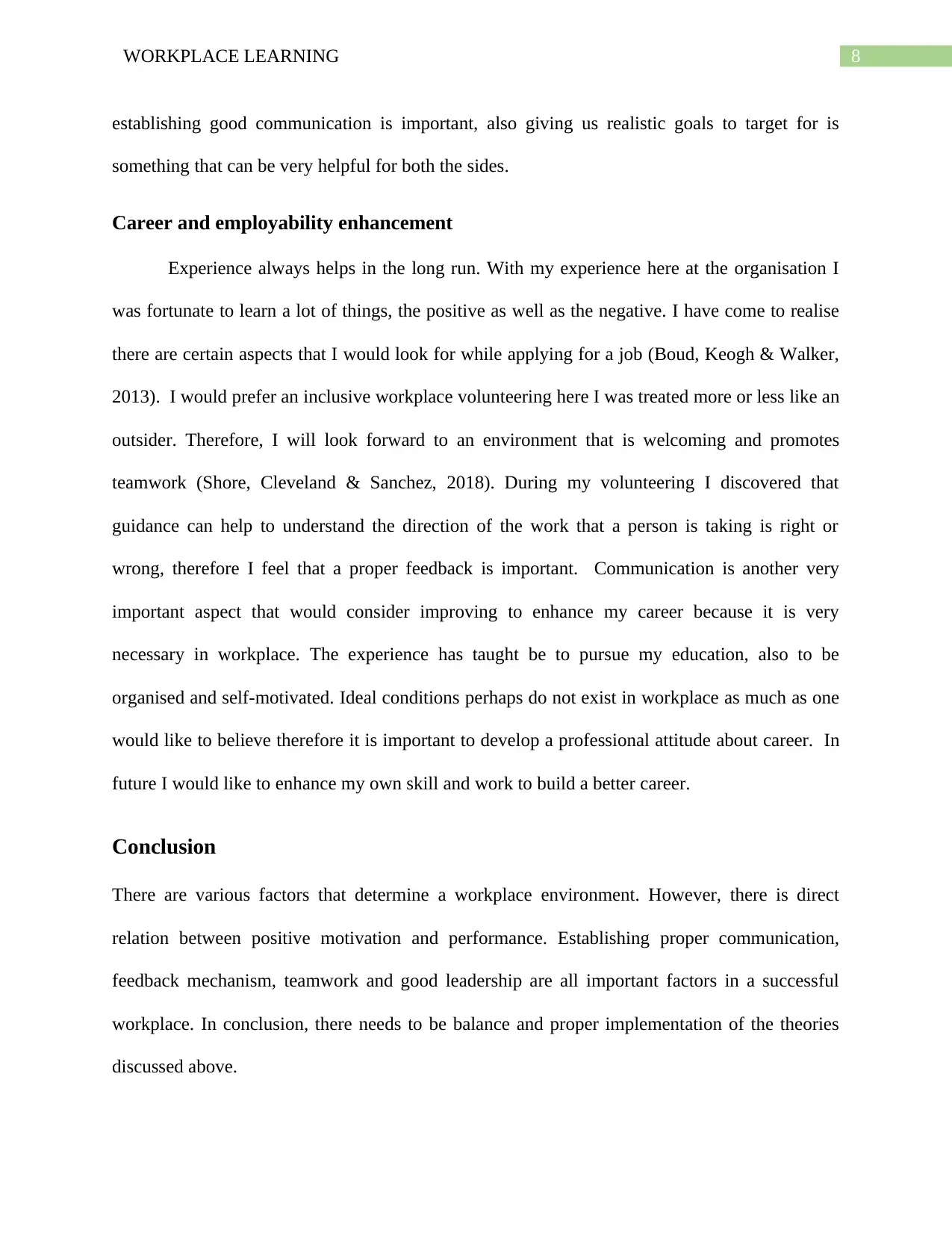
8WORKPLACE LEARNING
establishing good communication is important, also giving us realistic goals to target for is
something that can be very helpful for both the sides.
Career and employability enhancement
Experience always helps in the long run. With my experience here at the organisation I
was fortunate to learn a lot of things, the positive as well as the negative. I have come to realise
there are certain aspects that I would look for while applying for a job (Boud, Keogh & Walker,
2013). I would prefer an inclusive workplace volunteering here I was treated more or less like an
outsider. Therefore, I will look forward to an environment that is welcoming and promotes
teamwork (Shore, Cleveland & Sanchez, 2018). During my volunteering I discovered that
guidance can help to understand the direction of the work that a person is taking is right or
wrong, therefore I feel that a proper feedback is important. Communication is another very
important aspect that would consider improving to enhance my career because it is very
necessary in workplace. The experience has taught be to pursue my education, also to be
organised and self-motivated. Ideal conditions perhaps do not exist in workplace as much as one
would like to believe therefore it is important to develop a professional attitude about career. In
future I would like to enhance my own skill and work to build a better career.
Conclusion
There are various factors that determine a workplace environment. However, there is direct
relation between positive motivation and performance. Establishing proper communication,
feedback mechanism, teamwork and good leadership are all important factors in a successful
workplace. In conclusion, there needs to be balance and proper implementation of the theories
discussed above.
establishing good communication is important, also giving us realistic goals to target for is
something that can be very helpful for both the sides.
Career and employability enhancement
Experience always helps in the long run. With my experience here at the organisation I
was fortunate to learn a lot of things, the positive as well as the negative. I have come to realise
there are certain aspects that I would look for while applying for a job (Boud, Keogh & Walker,
2013). I would prefer an inclusive workplace volunteering here I was treated more or less like an
outsider. Therefore, I will look forward to an environment that is welcoming and promotes
teamwork (Shore, Cleveland & Sanchez, 2018). During my volunteering I discovered that
guidance can help to understand the direction of the work that a person is taking is right or
wrong, therefore I feel that a proper feedback is important. Communication is another very
important aspect that would consider improving to enhance my career because it is very
necessary in workplace. The experience has taught be to pursue my education, also to be
organised and self-motivated. Ideal conditions perhaps do not exist in workplace as much as one
would like to believe therefore it is important to develop a professional attitude about career. In
future I would like to enhance my own skill and work to build a better career.
Conclusion
There are various factors that determine a workplace environment. However, there is direct
relation between positive motivation and performance. Establishing proper communication,
feedback mechanism, teamwork and good leadership are all important factors in a successful
workplace. In conclusion, there needs to be balance and proper implementation of the theories
discussed above.
⊘ This is a preview!⊘
Do you want full access?
Subscribe today to unlock all pages.

Trusted by 1+ million students worldwide
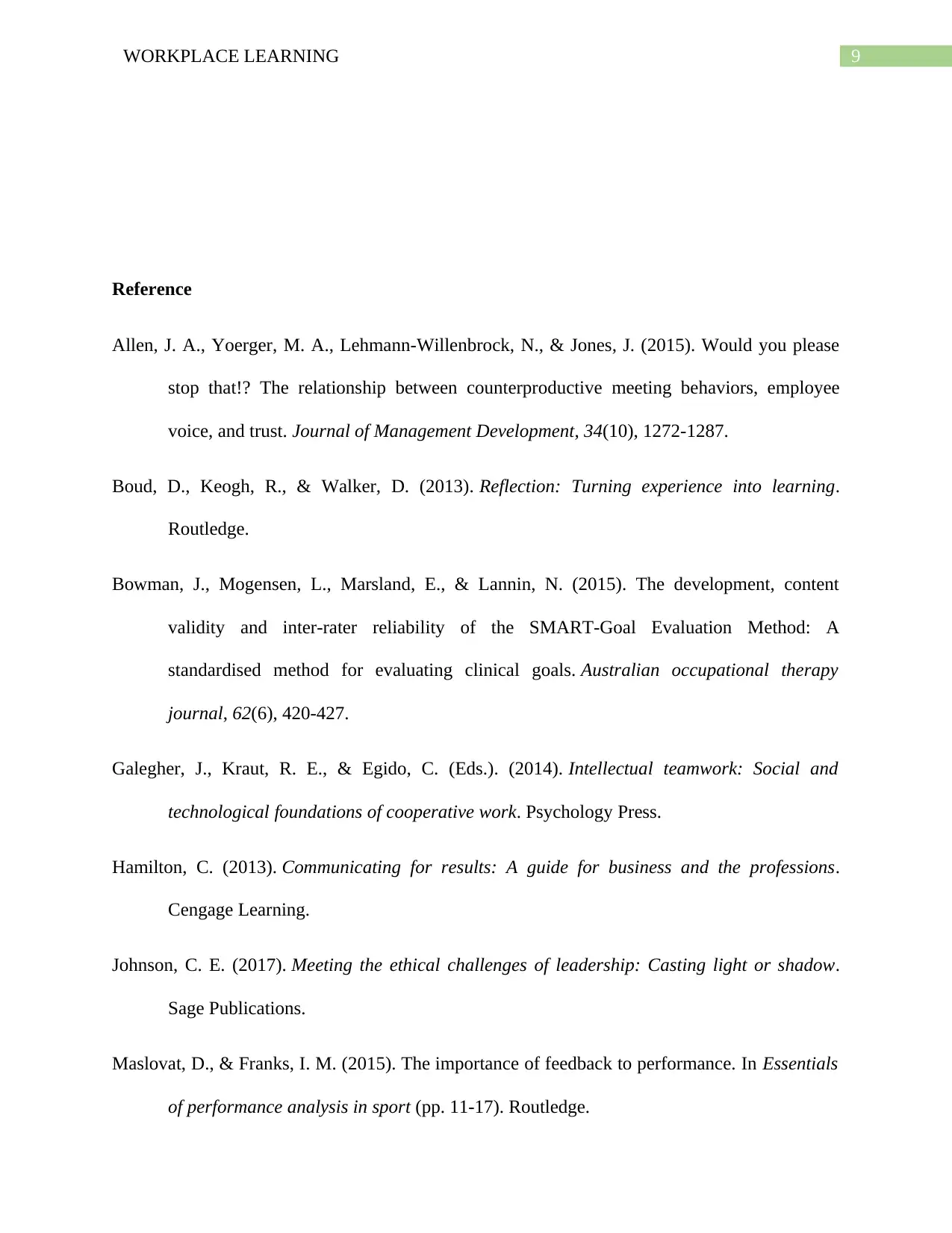
9WORKPLACE LEARNING
Reference
Allen, J. A., Yoerger, M. A., Lehmann-Willenbrock, N., & Jones, J. (2015). Would you please
stop that!? The relationship between counterproductive meeting behaviors, employee
voice, and trust. Journal of Management Development, 34(10), 1272-1287.
Boud, D., Keogh, R., & Walker, D. (2013). Reflection: Turning experience into learning.
Routledge.
Bowman, J., Mogensen, L., Marsland, E., & Lannin, N. (2015). The development, content
validity and inter‐rater reliability of the SMART‐Goal Evaluation Method: A
standardised method for evaluating clinical goals. Australian occupational therapy
journal, 62(6), 420-427.
Galegher, J., Kraut, R. E., & Egido, C. (Eds.). (2014). Intellectual teamwork: Social and
technological foundations of cooperative work. Psychology Press.
Hamilton, C. (2013). Communicating for results: A guide for business and the professions.
Cengage Learning.
Johnson, C. E. (2017). Meeting the ethical challenges of leadership: Casting light or shadow.
Sage Publications.
Maslovat, D., & Franks, I. M. (2015). The importance of feedback to performance. In Essentials
of performance analysis in sport (pp. 11-17). Routledge.
Reference
Allen, J. A., Yoerger, M. A., Lehmann-Willenbrock, N., & Jones, J. (2015). Would you please
stop that!? The relationship between counterproductive meeting behaviors, employee
voice, and trust. Journal of Management Development, 34(10), 1272-1287.
Boud, D., Keogh, R., & Walker, D. (2013). Reflection: Turning experience into learning.
Routledge.
Bowman, J., Mogensen, L., Marsland, E., & Lannin, N. (2015). The development, content
validity and inter‐rater reliability of the SMART‐Goal Evaluation Method: A
standardised method for evaluating clinical goals. Australian occupational therapy
journal, 62(6), 420-427.
Galegher, J., Kraut, R. E., & Egido, C. (Eds.). (2014). Intellectual teamwork: Social and
technological foundations of cooperative work. Psychology Press.
Hamilton, C. (2013). Communicating for results: A guide for business and the professions.
Cengage Learning.
Johnson, C. E. (2017). Meeting the ethical challenges of leadership: Casting light or shadow.
Sage Publications.
Maslovat, D., & Franks, I. M. (2015). The importance of feedback to performance. In Essentials
of performance analysis in sport (pp. 11-17). Routledge.
Paraphrase This Document
Need a fresh take? Get an instant paraphrase of this document with our AI Paraphraser
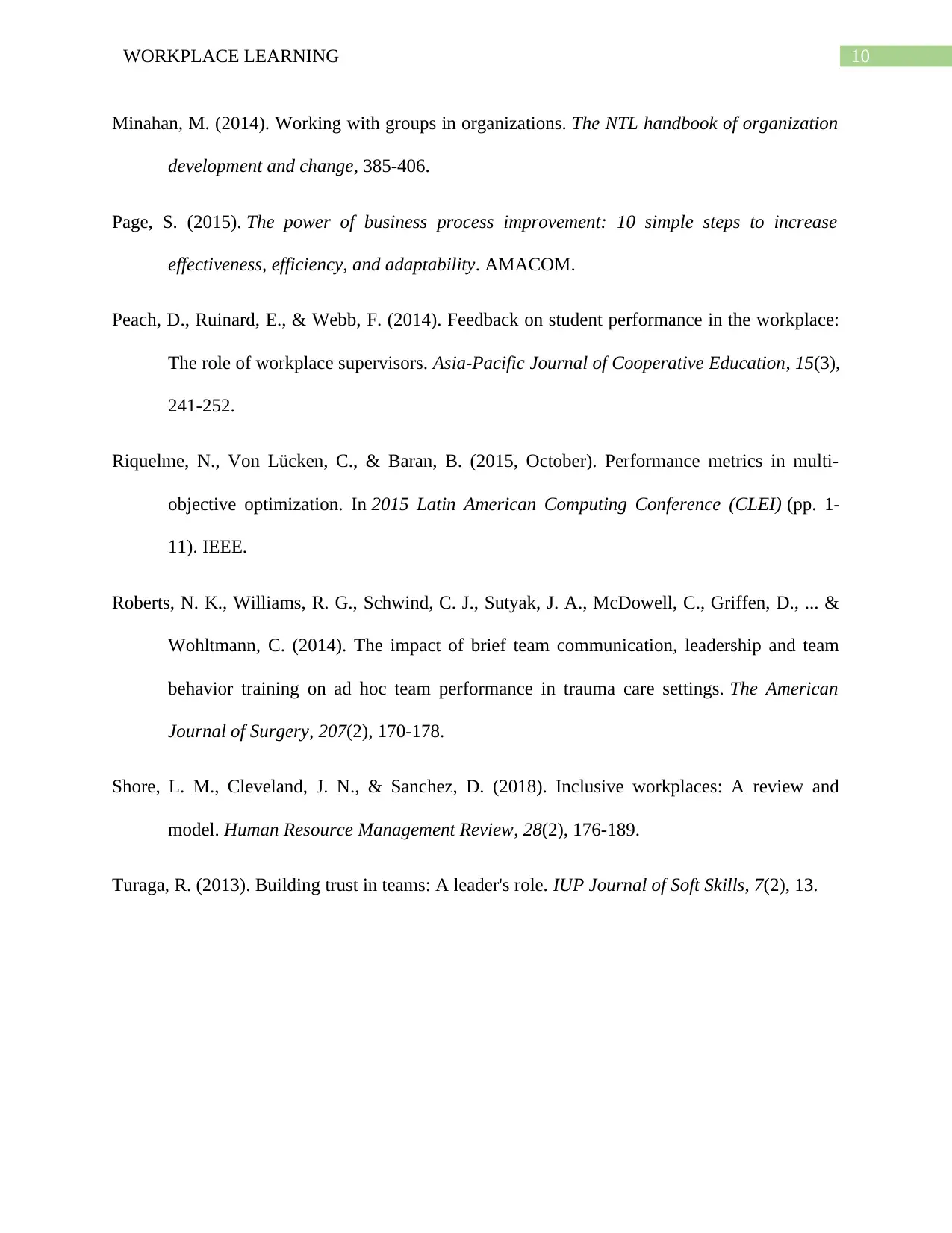
10WORKPLACE LEARNING
Minahan, M. (2014). Working with groups in organizations. The NTL handbook of organization
development and change, 385-406.
Page, S. (2015). The power of business process improvement: 10 simple steps to increase
effectiveness, efficiency, and adaptability. AMACOM.
Peach, D., Ruinard, E., & Webb, F. (2014). Feedback on student performance in the workplace:
The role of workplace supervisors. Asia-Pacific Journal of Cooperative Education, 15(3),
241-252.
Riquelme, N., Von Lücken, C., & Baran, B. (2015, October). Performance metrics in multi-
objective optimization. In 2015 Latin American Computing Conference (CLEI) (pp. 1-
11). IEEE.
Roberts, N. K., Williams, R. G., Schwind, C. J., Sutyak, J. A., McDowell, C., Griffen, D., ... &
Wohltmann, C. (2014). The impact of brief team communication, leadership and team
behavior training on ad hoc team performance in trauma care settings. The American
Journal of Surgery, 207(2), 170-178.
Shore, L. M., Cleveland, J. N., & Sanchez, D. (2018). Inclusive workplaces: A review and
model. Human Resource Management Review, 28(2), 176-189.
Turaga, R. (2013). Building trust in teams: A leader's role. IUP Journal of Soft Skills, 7(2), 13.
Minahan, M. (2014). Working with groups in organizations. The NTL handbook of organization
development and change, 385-406.
Page, S. (2015). The power of business process improvement: 10 simple steps to increase
effectiveness, efficiency, and adaptability. AMACOM.
Peach, D., Ruinard, E., & Webb, F. (2014). Feedback on student performance in the workplace:
The role of workplace supervisors. Asia-Pacific Journal of Cooperative Education, 15(3),
241-252.
Riquelme, N., Von Lücken, C., & Baran, B. (2015, October). Performance metrics in multi-
objective optimization. In 2015 Latin American Computing Conference (CLEI) (pp. 1-
11). IEEE.
Roberts, N. K., Williams, R. G., Schwind, C. J., Sutyak, J. A., McDowell, C., Griffen, D., ... &
Wohltmann, C. (2014). The impact of brief team communication, leadership and team
behavior training on ad hoc team performance in trauma care settings. The American
Journal of Surgery, 207(2), 170-178.
Shore, L. M., Cleveland, J. N., & Sanchez, D. (2018). Inclusive workplaces: A review and
model. Human Resource Management Review, 28(2), 176-189.
Turaga, R. (2013). Building trust in teams: A leader's role. IUP Journal of Soft Skills, 7(2), 13.
1 out of 11
Related Documents
Your All-in-One AI-Powered Toolkit for Academic Success.
+13062052269
info@desklib.com
Available 24*7 on WhatsApp / Email
![[object Object]](/_next/static/media/star-bottom.7253800d.svg)
Unlock your academic potential
Copyright © 2020–2025 A2Z Services. All Rights Reserved. Developed and managed by ZUCOL.




